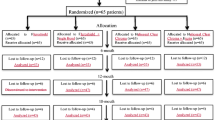Abstract
Aim: This was to assess the clinical performance of two different polymerization regimens of a non-rinse conditioning self/etching adhesive/sealant system (Adper Prompt-L-Pop®, 3M ESPE) placed in recently erupted first permanent molars in two paediatric dental practices. Methods: A total of 40 healthy 5 to 8 year old patients (20 from each practice), presenting at least two caries-free recently erupted first permanent molars, participated in this preliminary test. A total of 128 molars were fissure sealed (FS) and cured with two different curing regimens. Group1 (64 teeth) used Adper L-Pop + Clinpro as a one-step cure regimen. Group 2 (64 teeth) used Adper L-Pop + Clinpro with a two-step cure regimen using cotton-roll isolation. Sealants were evaluated 6 to 12 months after placement. Results: No differences were found in the ratings between the two polymerization regimens. In Group 1, 28 molars recorded FS fully retained rated A, 29 were rated B (partially missing) and 7 sealants were completely lost (C). In Group 2, 30 molars were rated A, another 30 scored B and 4 molars were totally lost (C). Conclusion: The poor performance of both FS polymerization regimens of the non-rinse conditioning self/etching adhesive/sealant system (Adper Prompt-L-Pop®, 3M ESPE) placed in recently erupted first permanent molars in the present test does not justify its use in young children.
Similar content being viewed by others
References
http://solutions.3m.com/wps/portal/3M/en_US/3M-ESPE/dental-professionals/products/category/preventive/clinpro-sealant/no-rinse-technique accessed on July 3, 2007
American Academy of Pediatric Dentistry Reference Manual 2001–2002: Clinical Guidelines on Pediatric Restorative Dentistry, p, 56–57.
American Academy of Pediatric Dentistry Reference Manual 2006–2007: Clinical Guidelines on Pediatric Restorative Dentistry, p, 123.
American Dental Association, Council on Dental Materials, Instruments and Equipment Pit and Fissure Sealants. J Am Dent Assoc 1987 114:671
Barrie AM, Stephan KW, Kay EJ: Fissure sealant retention: a comparison of three sealant types under field conditions. Com Dental Health 1990. 7:273–277
Cooney PV, Hardwick F: A fissure sealant pilot project in a third party insurance program in Manitoba. J Can Dent Assoc 60:140–145, 1994.
Feigal RJ: Sealants and preventive restoration: Review of effectiveness and clinical changes for improvement. Pediatr Dent 1998. 20:85–92
Feigal RJ, Musherurue P, Gillespie B, Levy-Polack M, Quelhas I, Hebling J: Improved sealant retention with bonding agents: A clinical study of two-bottle and single-bottle systems. J Dent Res 2000. 79:1850–1856
Feigal RJ. The use of pit and fissure sealants. Pediatr Dent 24:415–422.2002
Feigal RJ, Quelhas I: Clinical trial of a self-etching adhesive for sealant application: success at 24 months with Prompt L-Pop. Am J Dent 2003.16:249–251
Feigal RJ, Donly KJ: The Use of Pit and Fissure Sealants. Pediatr Dent 2006 28:143–150
Foreman FJ, Matis BA. Retention of sealants placed by dental technicians without assistance. Pediatr Dent 1991 13:59–61.
Hiiri A, Ahovuo-Saloranta A, Nordblad A, Makela M: Pit and fissure sealants versus fluoride varnishes for preventing dental decay in children and adolescents. Cochrane Database Syst Rev 2006 Oct 18; (4):CD003067
Houpt M, Shey Z. The effectiveness of a fissure sealant after 6 years. Pediatr Dent 1983 5:104–106.
Houpt M, Fuks A, Eidelman E: The preventive resin (composite resin — sealant) restoration: Nine-year results. Quintessence Int 1994. 25:155–159
Le Bell Y, Forsten L: Sealing of preventively enlarged fissures. Acta Odontol Scand 1980. 38:101–104
Messer LB, Calache H, Morgan MV: The retention of pit and fissure sealants placed in primary school children by Dental Health Services, Victoria. Austr Dent J 1997. 42:233–239
Romcke RG, Lewis, DW Maze BD, Vickerson RA. Retention and maintenance of fissure sealants over 10 years. J Can Dent Assoc 1990 56:235–237.
Shapira J, Eidelman E: Six-year clinical evaluation of fissure sealants placed after mechanical preparation: a matched pair study. Pediatr Dent 1986. 8:204–206
Silverstone ML: Fissure sealants: the susceptibility to dissolution of acidetched and subsequently abraded enamel in vitro. Caries Res 1977. 11:46–51
Simonsen RJ. Pit and fissure sealants. In: Clinical Applications of the Acid Etch Technique. Chicago, Ill: Quintessence Publishing Co, Inc; 1978:19–42
Simonsen RJ. Pit and fissure: review of the literature. Pediatr Dent 2002. 24:398–414
Simonsen RJ. Retention and effectiveness of dental sealant after 15 years. J Am Dent Assoc; 1991 122:34–42
Tay F R, Wei S HY, Pashley D H,Carvalho RM: Ultrastructure of resin-enamel bonds in unground enamel-occlusal fissures IADR 2003, Goteborg, Sweden, #0718
Venker DJ, Kuthy RA, Qian F,. Kanellis MJ. Twelve-month Sealant Retention in a School-based Program Using a Self-etching Primer/Adhesive Journal of Public Health Dentistry 2004 64(4), 191–197
Wendt LK, Koch G. Fissure sealant in permanent first molars after 10 years. Swed Dent J 1988. 12:181–185
Wendt LK, Koch G, Birkhed D. On the retention and effectiveness of fissure sealant in permanent molars after 15–20 years: A cohort study. Community DentOral Epidemiol 2001 29:302–307.2001
Author information
Authors and Affiliations
Corresponding author
Rights and permissions
About this article
Cite this article
Fuks, A.B., Kupietzky, A. Assessment of two curing systems in a self-etching primer/adhesive sealant: A preliminary study for a clinical trial. Eur Arch Paediatr Dent 8, 171–174 (2007). https://doi.org/10.1007/BF03262590
Published:
Issue Date:
DOI: https://doi.org/10.1007/BF03262590




